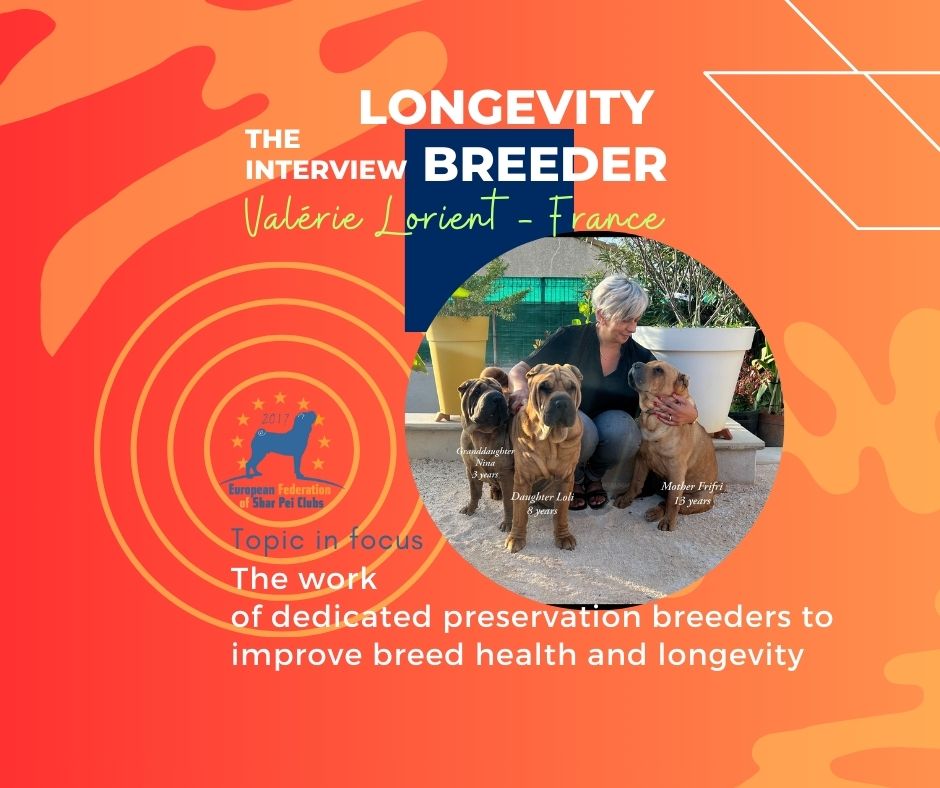Q&A with Longevity Breeder Valérie Lorient - France
Topic in focus: The work of dedicated preservation breeders to improve breed health and longevity
Q1: What are some of the most common myths about the breed?
This question makes me smile, because there are many, many myths about the Shar Pei …. some of them are funny and some less. The most famous that come to my mind are:
– Shar Pei don’t like water – Water is not something they enjoy the most, but some of them are excellent swimmers and have fun!
– Shar Pei are aggressive dogs – misleading information due to their past as fighting dogs.
– Shar Pei cannot be trained – absolutely wrong! With a proper socializing and daily training Shar Pei are wonderful family’s companions.
-Shar Pei have a foul smell because of their wrinkles ….or wrinkles needs to be powdered – but the worse I heard is the puppy’s price relative to the number of wrinkles… ! More wrinkled, more expensive!
Q2: In you opinion, has the Shar Pei breed overall evolved and improved in the past decades? What are some of the efforts preservation breeders have made in this regard?
First of all, we must be grateful for the work that has been done in the past by all breeders and pioneers of the breed, because it is also thanks to them that we can continue to write a part of its history.
In the past decades, the breed has experienced ups and downs like many other breeds.
Overall, Shar Pei breeders were able to maintain the breed at a correct level and knew to preserve some of the famous and unique features that make a Shar Pei a Shar Pei.
Unfortunately, some essential points have been neglected such as the coat quality, its length for example, but not only this. I think that during a considerable amount of time, the color of the coat was the first point some breeders focused on, leaving aside the breed standard and its distinguished characteristics. In the past few years, some major changes have occurred, bringing priorities such as type, health to the #1 top concerns a breeder must look at with a certain consciousness.
I have the feeling that after a few chaotic years, the breed is returning to a slightly higher level by reason of a certain consciousness of the breeders. We breed more responsibly, more selectively, with the aim to fix a balanced type, healthier and gaining in longevity.
In the meantime, the appearance of genetic tests and tools has significantly changed our way to breed, allowing us to refocus on health and type as a prior.
Nowadays, breeders have the will to make this breed a healthier one. A positive synergy and cooperation circulate between breeders, who share the same idea of improving the Shar Pei breed, preserve it from drifts and keep it as this wonderful and unique dog it is.
And finally, I’m happy and delighted to see again a strong interest in horse coat and their comeback in the breeding lines … they are so special to me and their unique characteristics make them crucial for the breed itself for many, many reasons, one of which is to correct the coat texture.
Q3: Do you see any improvements in overall longevity? And if so, what has contributed to this?
The Shar Pei has always had the reputation of not living until an old age and has always been considered as a dog whose longevity was almost non-existent. During a certain time, that was true.
Many dogs left at young ages, leaving their breeders and their families in deep distress without sometimes understanding why. Why some of them left while others lived up to 14 years? I have often wondered about this, and, in my opinion, many genetic and environmental factors can interfere and impact the longevity.
In its entirety and nowadays we can all see that our Shar Pei age better, live longer by reaching great ages in excellent condition. WHY? – to this question I would answer that the way we live with our dogs has changed for the better. We are more attentive to the quality of life we can offer our dogs; the quality of food and activities have certainly improved this condition, I am convinced. To this, I would add that a solid basis in genetics coupled with a serious study of pedigrees can undoubtedly help and guide some of our choices to mate or not.
Q4: How do you address longevity in your breeding program?
Longevity is a selection criteria that I focus on when I think about future mating or when I decide to acquire a new dog. I would even say that this is the first thing I will ask about – the bloodline of a pedigree and all ancestors relative to this.
I have always mated my dogs by considering the longevity as an essential criterion and put this point equally to others I look for.
By the way, I would not hesitate to use a very old dog in breeding, if the opportunity comes.
That’s the whole point and not doing so, would be a shame; it is too bad to deprive yourself of a dog whose genetics allowed it to live a long lifetime, and which will allow you to benefit from some of its genes for improving the breed.
From my experience, and with no less than 40 years of living together with my dogs, I was able to observe how my dogs age, their behavior within a group and what motivates them to stay connected to life. I learned a lot from them. So yes, seeing them age is not always easy, but it is with love and respect that I accompany them to the end. They are so precious, it could not be otherwise.
Q5: How do you see the shar-pei breed developing in the future?
This question is relevant and relatively important to me.
My answer will be a few words: I would like to see in the future a Shar Pei, that looks like a Shar Pei. Today our breed is absolutely no longer homogeneous, due to too many different types. The work that has been done against the hyper-type and which we continue is a successful one, the Shar Pei of today is a less wrinkled one, less heavy, often more athletic and much healthier. I would say that all actors in the Shar Pei sphere are determined to work in this direction in order to improve health conditions in the breed. We can really congratulate ourselves on this progress.
However, I remain mostly concerned and I often wonder how the type will evolve if we focus only on health? From my point of view, it is imperative to continue to work equally on both – health, but also on the type and its standard. We must think about preserving what makes the richness of the Shar Pei breed, otherwise we will definitely lose the name “Shar Pei”….
Nevertheless, I remain confident about the future of Shar Pei, as long as it does not fall into excesses, ensuring that it does not cross the red line between the two extremes – Too much or not enough – we are not good.
The majority of us love this breed more than ourselves, I am sure that the right compromise will be found to keep intact the DNA of this breed!
Thank you.

